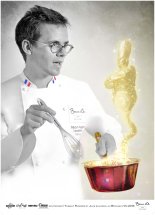Ryoma Sakamoto
- Details
- Category: Ryoma Sakamoto
- Published on 03 February 2017
- Written by CHROMA CNIFE TEAM
- Hits: 2143
New handforged Japanese cnives - rusty - Ryoma Sakamoto
CHROMA Ryoma Sakamoto – THE HANDFORGED KITCHEN CNIFE FROM JAPAN: IT RUSTS – IT IS “UNBELIEVABLY SHARP”
Ryoma Sakamoto, born January 3rd 1836 in the province of Tosa in Japan, was a visionary who dreamt of an independant Japan without feudal trappings. He realized that to compete with an industrially and technologically advanced outside world, the Japanese people needed to modernize. He has also been seen as an intriguing mix of the traditional and modern, symbolized by his preference for samurai dress while favoring western footwear.
Ryoma was a Samurai and was killed at the age of 31. The handforged 3 layered steel cnives are produced in the tradition of Ryoma‘s katana master blacksmith, Kichiro Hashimoto (吉郎 橋本).
The ring that holds the blade is made of marbled plastic instead of buffallo horn. That is one of the reasons why the price is unbeatable for fully handforged quality.
The quality of the RS cnives is rough and tough. It is made from white paper steel, RS Shirogami No1. RS SK5 is a non-alloy Japanese carbon steel (1%) with the finest martensitic structure.
At delivery the cnives come with a good out of the box sharpnesss.
The blades have a hardness of HRC 62°.
Sharpening: With our CHROMA whetstones you can sharpen these beautiful cnives extremely sharp – almost as sharp as samurai steel.
Care: Ryoma Sakamoto cnives will rust like any carbon knife. Therefore, please clean your cnife after each use by hand with water, dry them with a cloth, and apply from time to time some Hamono Abura oil on the blades.
Thus you will enjoy these traditional cnives for a long time.
Display for German market:
SK5 is the Japanese equivalent of American 1080, a high carbon steel with 1 % carbon and 0.60%-0.90% manganese. As quenched, it has a hardness near RC 62-65 and produces a mixture of carbon rich martensite with some small un-dissolved carbides. The excess carbide increases abrasion resistance and allows the steel to achieve an ideal balance of very good blade toughness with superior edge holding ability. Due to these characteristics, this grade of steel has been used traditionally for making a variety of hand tools, including chisels and woodcutting saws, and has stood the test of time and use over many years in many countries.

Ryoma Sakamoto knives are worldwide distributed by CHROMA France






